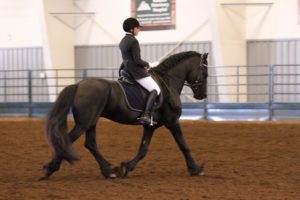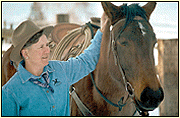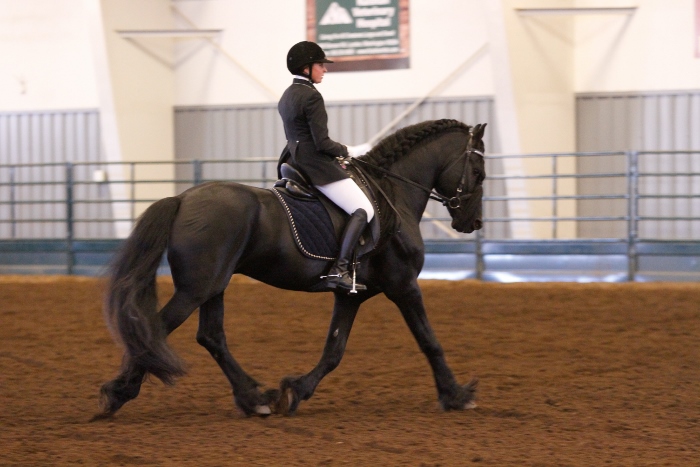Part 4: Practicing Lateral Maneuvers to Achieve Lightness
by Alice Trindle
As we finish up this series of articles regarding balance I am again drawn to the reality that this is the critical element in our journey to achieve true lightness with horses. Actions, postures and maneuvers that reflect a life out of balance will never lead to a place of harmony and equilibrium when riding. So, it seems very appropriate that we have spent the last three months discussing our role in understanding this important key ingredient— both mentally and physically—on the ground and in the saddle. When operating in a state of balance any job can be accomplished with horses.
 Let’s begin with a brief review: We started with examining physical and attitude balances for both horse and human, and concluded that balance was a key element for enabling movement with the horse if we desire to ride them. Next, we moved to observing how balance is affected by movement, and we accomplished this by watching our horses during various ground exercises. Our third installment began with looking at how we can influence the balance from the saddle or upon the horse’s back by utilizing a Horseman’s Protocol, having ever present vigilance regarding our posture and use of our aids. This awareness of employing these key elements hugely affected our success in seeking that balanced place. This has brought us to a final examination which explores how to apply what we’ve learned with some specific sample maneuvers to achieve a state of lightness in balance.
Let’s begin with a brief review: We started with examining physical and attitude balances for both horse and human, and concluded that balance was a key element for enabling movement with the horse if we desire to ride them. Next, we moved to observing how balance is affected by movement, and we accomplished this by watching our horses during various ground exercises. Our third installment began with looking at how we can influence the balance from the saddle or upon the horse’s back by utilizing a Horseman’s Protocol, having ever present vigilance regarding our posture and use of our aids. This awareness of employing these key elements hugely affected our success in seeking that balanced place. This has brought us to a final examination which explores how to apply what we’ve learned with some specific sample maneuvers to achieve a state of lightness in balance.
The human tendency to “make” things happen from the saddle is often easily observed in lateral movements. Going sideways, both away from the bend (i.e. leg yield postures) and into the bend (i.e. half-pass postures) are critical movements for most horsemanship disciplines. In accomplishing these sideways maneuvers we must be vigilant about balance, otherwise we will end up pushing and bracing our way through them in an unflattering way. Here is a breakdown for achieving flowing sideways maneuvers that are in balance with your horse:
Leg yield postures are movements where the horse moves away from the bend, he carries his weight from the inside hind quarter towards the outside shoulder, and he is slightly bending to the inside, while his body moves opposite the bend. We use these postures to accomplish tasks such as opening a gate from atop our horse, shaping and positioning in cow work, or to move off the trail to let the llamas pass. If, for example, we are moving sideways and forward, to the right, then the horse would be shaped laterally slightly to the right, and you could see his right eyelash. After taking a deep breath and visualizing this movement of right to left on a diagonal, your body will start to naturally prepare your aids. Your balance will come slightly to the left, into your left seat bone, your left elbow will feel a bit heavier, your left leg will relax and get longer, and finally the “fruit basket” on top of your head will move from center to slightly left of the horse’s mane line. Your pressure aids are helping the horse keep the proper bend (to the right), caressing at the girth with the right calve, and sending the energy from the right hind quarter to the left shoulder and rein. The left rein accepts this energy with a slight caress as the supportive rein. There is no need for any gross opening of the left rein, and certainly not a gross opening of the left leg. Simply relax the outside leg, and allow the horse to move sideways and forward in rhythmic balance.
Half-pass postures are movements where the horse moves into the bend, generally carries his weight from the outside hind quarter to the inside shoulder, and his lateral bend is maintained in the direction of travel. We should use half-pass postures to accomplish tasks such as correct turn-on-the-haunch, set up for canter pirouette and some positioning in cow work. So, if we are moving sideways and forward to the right, the horse is shaped to the right, and you could see his right eyelash. After checking in to make sure you are present, taking that deep breath and visualizing the movement and pattern you wish to ride, your posture will already start to dictate to your aids. Your focus is slightly to the right, your weight moves into the right seat bone, the right elbow is heavy, and your shoulder-blade weight is slightly to the right. The pressure aids are minimal as you don’t want to think of “pushing” your horse sideways in the half-pass. Rather, the left or outside leg moves slightly back and holds the haunch, encouraging the movement from the left hind to the right fore, and into the right rein. Your right leg relaxes and grows a little longer, and may have to caress slightly to remind the horse that the bend is to be maintained to the right.
We have only begun to scratch the surface of the depth of what performing in balance will lead us to in relationship with horses. May you continually seek balance and find lightness in all that you do.
Useful Reading & Materials:
Riding Essentials, by Francous Lemaire de Ruffieu
Advanced Dressage, by Anthony Crossley
Fundamentals of Dressage, by Alfred Knopfhart
Articles and Videos by Alice Trindle at: www.tnthorsemanship.com
Published August 2014 Issue

Alice was born on a ranch in eastern Oregon, the only daughter in a family of five brothers. She learned to ride behind the back of the saddle holding on to her brother’s belt loops. In the past 15 years Alice has studied with horsemen such as Tom Dorrance, Ray Hun, Dennis Reis, and Bettina Drummon. Her focus is on building a balanced relationship, applying Classical Dressage and Traditional Vaquero principles, via multi-day horsemanship retreats at her ranch in eastern OR.






